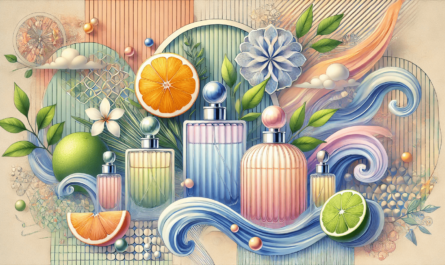Scents have long ceased to be just companions of everyday life, it is now a way to express yourself without words. They have become art that tells whole stories. Each perfume is a complex composition that reflects emotions, memories and events that cannot be described in words. In the world of perfume, notes are transformed into images, allowing you to create something more than just a smell. This unique combination turns the fragrance into a narrative tool similar to the literary genre, only in a different form.
Each perfume composition has a beginning, development and completion, as in this book. The opening notes evoke instant associations, the middle notes reveal themselves after a while, and the base notes leave a deep and long trace. This can be compared to a classic story, where the first pages attract attention, and the ending leaves the readerto ponder and worry. Perfumers, like authors, choose ingredients to create unique stories that will remain in the memory for a long time. As with choosing a perfume, it is important to consider how the fragrance interacts with the person’s personality and style.
Using complex chords and compositions, the fragrance masters play with the imagination, creating images that transport us to other worlds. Notes can remind you of long-forgotten memories, awaken feelings, or even inspire dreams. This literary nature of perfumery opens up new horizons for the perception of art, where each smell becomes a symbol of a new plot.
Fragrance as a narrative
Each fragrance, like the book, begins with intrigue. The opening notes of the perfume are instant sensations that create the first image and set the direction of the entire work. Here, it’s important that this first step captures attention, because it’s what decides whether the “reader” — the person who inhales the fragrance — will remain engaged in the story. Perfumers, as talented storytellers, skillfully use the opening notes to create the first powerful emotional response.
The middle notes of the perfume are its heart, the central part, where the main idea is revealed. These notes sound longer and deeper, forming the main theme of the fragrance. Just as in a novel, where after an exciting beginning comes the turn of revealing characters and events, here the real story begins. It is at this point that the fragrance begins to truly live on the skin, creating a unique impression.
The final base notes are a finale that leaves a trace, sometimes long and persistent, like the aftertaste of a book you’ve read. They sound quieter, but last longer, staying with us for many hours, and sometimes even days. The finale of a fragrance, like the finale of a book, can be bright and memorable or, on the contrary, quiet and inconspicuous, but it always completes the story, creating a complete impression of the work.
The art of creating aromatic literature
Perfumers create their works, just as writers construct phrases and paragraphs. Each component of the fragrance can be a metaphor or symbol, creating depth and variety. The composition should be harmonious, so that the notes, as separate words, merge into a single story. A fragrance, like a text, consists of many details that together form a complete work.
To create such a complex product, perfumery masters carefully select the ingredients. Each of them should serve a specific purpose and be combined in harmony with the others. The component selection process includes several key steps:
- Selection of starting notes for a bright start.
- Identify heart notes that will reveal the main theme.
- Choose the base notes for a long and lasting finale.
All this requires great skill and attention to detail to complete the composition. Each fragrance is unique, and this is what makes it like a literary work that can be “read” with each inhalation.
The sensations of the fragrance can change our perception of the world, immersing us in the atmosphere of the created story. Like a literary work, a fragrance can transport us to a different temporal or spatial context. The feelings evoked by scents are so deep that they can evoke associations with specific moments in life or imaginary scenes. This process is similar to reading, where each reader creates their own interpretation of the text.
Poetics of perfume compositions
Perfumers use complex aromatic chords to create images that evoke the imagination. They play with contrasts, combining sweet, spicy and fresh notes, creating multi-layered stories that unfold over time. In this process, it is important not only to choose the right ingredients, but also to properly build their interaction. Just as a writer chooses words to create a mood, a perfumer creates compositions to express emotions.
The development of a fragrance over time is similar to the development of a story in a book. When a person feels the fragrance for the first time, it is like the first pages of a novel, which set the tone for the entire work. As the fragrance unfolds, its notes begin to change character, just as the characters of a literary work are revealed from a new side. This gradual process makes the perception of the fragrance multi-faceted and unpredictable, which increases its “literary” quality.
The final fragrance leaves a lasting impression, comparable to the last pages of a book, which often remain in the reader’s memory. The end of the perfume composition is the moment when the base notes become dominant and remain on the skin for a long time. This final chord can change the perception of the entire fragrance, making you think about its depth and complexity. This is where the fragrance lives out its history, creating an unforgettable experience.
Symbolism of aromas
Aromas, like literary works, are full of symbolism and hidden meanings. Perfumers often play with aromatic symbols to convey deeper meanings. For example, rose notes can be a symbol of love or passion, depending on the context of the fragrance and its surroundings. This approach allows perfumes to speak the language of emotions, which can be deciphered by immersing themselves in the history of the fragrance.
Each smell carries a specific cultural meaning, which can vary depending on the time and place. Just as literary images can have different interpretations depending on the era or region, scents can evoke different associations in people from different cultures. The fragrance is a bridge between cultures, it conveys universal sensations through unique notes and chords.
The power of symbolism in scents lies in their ability to convey the invisible and intangible. As in literature, where the writer conveys feelings through words, the perfumer creates images using aromatic molecules. This process allows you to turn each fragrance into an independent work of art, which can not only be worn, but also comprehended as a literary work.
Questions and answers
They use notes as words, creating multi-layered stories with a beginning, development, and end.
Symbolism is shown in the choice of notes that can express feelings and emotions similar to literary symbols.
They evoke emotions and associations, transporting us to different worlds, like literary works.




